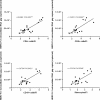Expression of HERV-Fc1, a human endogenous retrovirus, is increased in patients with active multiple sclerosis
- PMID: 22278236
- PMCID: PMC3302483
- DOI: 10.1128/JVI.06723-11
Expression of HERV-Fc1, a human endogenous retrovirus, is increased in patients with active multiple sclerosis
Abstract
Multiple sclerosis (MS) is considered to be an autoimmune disease with an unknown cause and with immune system dysregulation. Among environmental factors, viruses are most often connected with the etiology of MS. Human endogenous retroviruses (HERVs) constitute 5 to 8% of human genomic DNA and have been detected as transcripts and proteins in the central nervous system (CNS) and peripheral blood, frequently in the context of neuroinflammation. HERV-Fc1, which belongs to the HERV-H/F family, has received our attention largely because of the genetic association with MS. We studied the expression of a capsid (Gag) protein of HERV-H/F origin by flow cytometry in peripheral blood mononuclear cells (PBMCs) from healthy controls and from MS patients with nonactive or active disease. There was a significant increase in HERV-H/F Gag expression in CD4(+) (P < 0.001) and CD8(+) (P < 0.001) T lymphocytes and in monocytes (P = 0.0356) in PBMCs from MS patients with active disease. Furthermore, we have undertaken the first rigorous SYBR green-based absolute quantitative PCR (Q-PCR) evaluation approach to quantify extracellular HERV-Fc1 RNA viral loads in plasma from MS patients and healthy controls. We found a 4-fold increase in extracellular HERV-Fc1 RNA titers in patients with active MS compared with healthy controls (P < 0.001). These findings strengthen the link between HERV-Fc1 and the pathology of MS. The cause and biological consequences of these differential expression levels will be the subject of further investigation. HERV-Fc1 biology could be a compelling area for understanding the pathology of MS and possibly other autoimmune disorders.
Figures





References
-
- Aranami T, Yamamura T. 2008. Th17 cells and autoimmune encephalomyelitis (EAE/MS). Allergol. Int. 57:115–120 - PubMed
-
- Benit L, Calteau A, Heidmann T. 2003. Characterization of the low-copy HERV-Fc family: evidence for recent integrations in primates of elements with coding envelope genes. Virology 312:159–168 - PubMed
-
- Ben-Nun A, Cohen IR. 1982. Experimental autoimmune encephalomyelitis (EAE) mediated by T cell lines: process of selection of lines and characterization of the cells. J. Immunol. 129:303–308 - PubMed
-
- Brudek T, Christensen T, Hansen HJ, Bobecka J, Moller-Larsen A. 2004. Simultaneous presence of endogenous retrovirus and herpes virus antigens has profound effect on cell-mediated immune responses: implications for multiple sclerosis. AIDS Res. Hum. Retrovir. 20:415–423 - PubMed
Publication types
MeSH terms
Substances
LinkOut - more resources
Full Text Sources
Other Literature Sources
Medical
Research Materials

